|
Dinesh Yadav Research Scholar Amity International Business School Amity University Uttar Pradesh, Noida, India |
Gurinder Singh Group Vice Chancellor Amity Universities, India, Director General Amity International Business School, Amity University Uttar Pradesh, Noida, India |
Kartik Dave Professor and Dean School of Business Public Policy & Social Entrepreneurship (SBPPSE) Ambedkar University Delhi (AUD), Delhi, India |
R. S. Rai 4 Professor - Decision Sciences Amity Business School, Dy. Director - Research Planning & Statistical Services Amity University Uttar Pradesh, Noida, India |
India has witnessed an exponential growth of internet users in the recent years and the cybercrime which resulted as unavoidable by-product of greater internet usages, has also witnessed an exponential growth. User’s Internet habits play an important role in cybercrime victimization. In the present study, a cross- sectional study was done among various sections of internet users in the district of Gautambuddh Nagar, Uttar Pradesh. Cyber awareness, cybercrime victimization, exposer to motivated offenders (internet hours per day), online security measure awareness, popularity of social media platforms, sources of online information and online habits of the internet users were examined for ascertaining the presence of gendered differences (if any). Cyber awareness in females was found to be significantly more than the males in seven items out of the twelve items of the cyber awareness construct. Majority of the respondents felt that women were soft target of cybercrimes. Males outnumbered the females significantly in watching pornographic content online. Males were found significantly exposed more to internet than the males. Females were found to be significantly less aware than males as far as online security measures were concerned. Males were found to be using social media sites significantly more than the females. Gendered differences were also found between accessing the sources of online information.
Keywords –Cybercrime, Social Media Platforms, Online Security, Cyber AwarenessInternet and social media usage in all social classes has seen exponential expansion over the time. The use of internet and social media spreads in both developed and developing countries(Ang, 2017). Internet is being extensively utilized as a popular and useful means of retrieval of information, social networking and entertainment (Tsimtsiou, Dantsi, Sekeri, Trikoilis, & Nanos, 2017).As of January 2018, the number of internet users in India were 462 million, and ranked second in world (Statistics Portal, 2017). There were430millionactive mobile internet users, 250 million active social media users and 230 millionactive mobile social media users (“India: digital population 2018 | Statistic,” 2018) .As of October 2015, 71% of the internet users in India were males (“Internet usage in India - Statistics & Facts | Statista,” n.d.). The (“India: number of Facebook users 2022 | Statistic,” n.d.) found that there were 219 million Facebook active users in India which is expected to reach 291 million by 2022. These statistics show that there is very deep penetration of internet and social media in India and therefore internet has become a very popular mode of information seeking, communication, social networking and commercial transactions.(Parihar & Raheja, 2018)In a study revealed that the youth in India was ready for internet censorship and thought of it as a means to preserve national security and cybercrime. Although, there is a rising apprehension regarding the way people use internet, their awareness about the cyber culture and cybercrime. However, it has received very little research attention. There are many forms of internet users’ habits. The internet users may develop habits to content and platform for surfing internet. Internet user may develop online habits of mode of accessing internet, performing specific online activities, extent of using mobile phone for accessing internet etc.(Wang, Luo, Gao, & Kong, 2012) have discussed that computer and internet technology are influencing the lives of people.(Tokunaga, 2017) has reviewed and discussed that Internet habits can take many forms and studies have shown that internet users have developed habits such as watching online pornography, gaming, accessing social networking sites and accessing news etc.(Leung, 2009) has argued that with the advent of new media technologies accessible through internet viz. e-mail, blogs, online games, mobile phones, iPods, MP3, PS3 video on demand etc. have intensely changed the both the nature and number of social compensation and mood management devices. In recent years there has been an exponential increase in cybercrime, which resulted as an unavoidable byproduct of greater internet usage. This increase in cybercrime presents big range of criminal threats to companies and individuals in same manner (Miller, Higgins, & Lopez, 2010). This study focused upon reviewing the habits of internet users and awareness regarding cybercrimes among the residents of Gautam Budh Nagar district of Uttar Pradesh state in India. The research is exploratory and descriptive in nature. An effort was made to analyse the cyber culture awareness, experience of cybercrime victimization, internet use or exposure to motivated offenders, online habits and activities, types of activities using mobile phones, cyber awareness, awareness about online security measures and usage pattern of social media networking sites, and sources used for online information.
A cross sectional study was conducted among various categories of internet users in the district of GautamBudh Nagar of Uttar Pradesh from September to November, 2018. The population of the study was the residents of district Gautam Budh Nagar of Uttar Pradesh state, India. The sample comprised of the internet users, which included residents of the district comprising of students (9th class to 12th class, undergraduate & postgraduate), IT professionals, teachers, industry workers etc. The research instrument to collect the data was a structured questionnaire. The questionnaire was designed so that internet habits and cyber awareness of the respondents is captured fully.Prior to the study a piolet run was conducted on 25 respondents to examine the structure and content of the questionnaire. The feedback received from the pilot survey was incorporated to further modify and enrich the questionnaire. The final questionnaire was administered to the target population. A total of 1350 questionnaire were distributed in the district out of which 1011 responses were received. The responses were sought from the respondents who have at least received basic school education. The collected data was codified, cleaned and entered into the statistical Package for Social Sciences (SPSS) version 20.0 for windows for analysis. Validity and reliability of the questionnaire was ascertained before administering it. Face validity of the questionnaire was ascertained by three senior professors and subject experts. The reliability assessment of the sub-components of the questionnaire post data collection revealed a Cronbach’s alpha value of 0.785 for Experience of Cybercrime Victimisation (26 items), 0.708 for Cyber Awareness (12 Items), 0.831 for Online Security (7 Items), 0.774 for Popularity Social Networking Sites (7 Items), 0.784 for Sources for online information (6 items). The results were obtained using frequencies and percentages. The relationships among gender and constructs of cyber awareness and internet habits were analyzed using cross tabulation and Pearson’s Chi-squared test. The p-value < 0.05 was considered as statistically significant.
The demographic information sought in the questionnaire included gender, age, marital status, educational background, employment status and family income. The sample respondents were composed of 622 (61.52%) male and 389 (38.48%) female. The respondents were aged between 13 and 74 years (Mean = 23.15, SD = 8.30). The respondents were educated and have received at least basic school education with 66.37% of the sample having under graduate or post graduate or above qualification while 33.63% of them having completed at least basic school education. 716 (70.82%) of the respondents were students while 295 (29.18%) were in some employment. 909 (89.91%) of the respondents were unmarried and 102 (10.02%) were married. 421 (41.64%) of the respondents have reported their monthly family income as less than Rs 1 lakh, 188 (18.59%) have reported as between Rs 1 lakh and 2 lakhs, 175 (17.22%) have reported as Between 2 lakhs to 5 lakhs and 227 (22.45%) have reported as more than 5 lakhs. This shows that the sample comprised of almost all sections of the society having fair representation of sections in both the genders. The analysis was conducted on the items measuring cyber awareness, cybercrime victimization, exposure to motivated offenders or internet hours per day, online security measures awareness, popularity of social media sites, sources of online information and online habits. Since the data was on nominal and ordinal scale, the gendered differences were ascertained using non-parametric Pearson’s Chi-squared test.
Cyber awareness construct was measured through twelve items. Association between gender and cyber awareness is presented in table 1. Seven items have shown significant association between gender and their opinion about the items while non-significant association was found in five items. This analysis points to the fact that there are gendered differences in cyber awareness in majority of the items of the cyber awareness construct. It was found that the cyber awareness in the females is more than males.
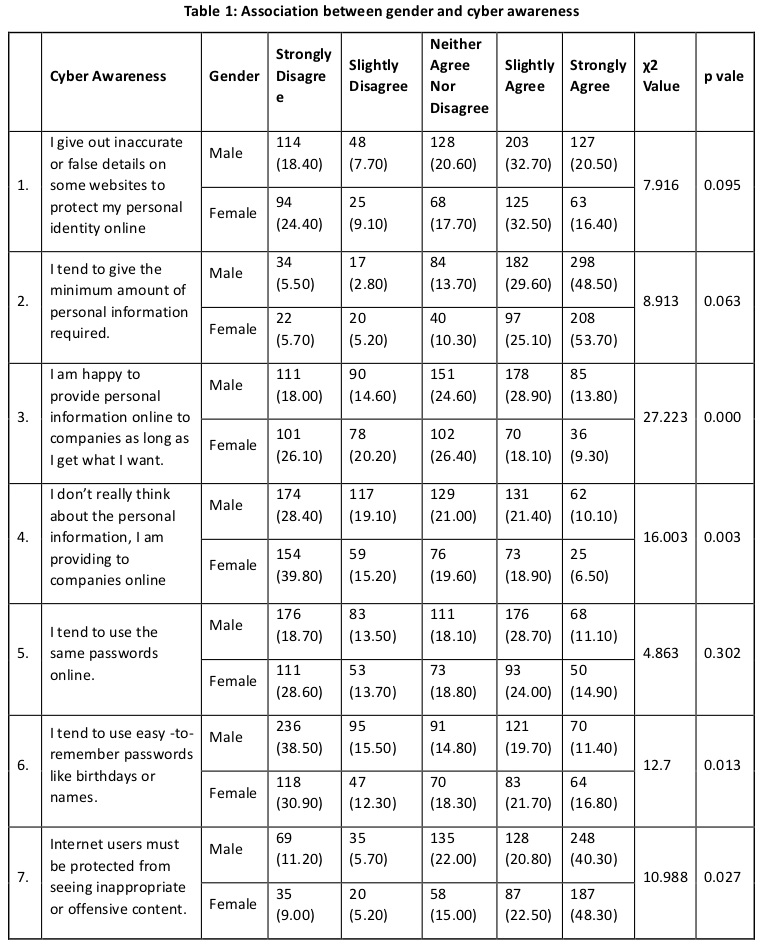
Table 2 presents how significant is the association of gender with cybercrime victimization. It shows that 117 (18.84%) male and 71 (18.35%) female respondent experienced computer hacking, 151(24.32%) male and 76(19.69%) female e-mail account or social media account hacking. The study reveals that 105(16.94%) male and 49 (12.79%) female respondents fell victim of online Identity theft and 225(36.29%) male and 142(22.90%) female respondents were cyber stalked. Study also revealed that 104(16.83%) male and 51(13.25%) female were cyber defamed, 109 (17.69%) male and 57 (14.84%) female were impersonated online and 204(33.06%) male and 85 (22.19%)female received abusive/ dirty emails from strangers. 402(65.25%) male and 194(51.32%) female reported to be a victim of phishing attack, 461 (74.60%) male and 260 (67.18%) female reported to be a victim of virus attacks and 193 (31.05%) male and 95 (24.44%) female reported to be a victim of cyber financial frauds. 489 (79.13%) male and 249 (64.51%) reported that they received unsolicited emails. 388 (62.58%) male and 262 (67.7%) female feels that women are soft target of cybercrimes. 279 (45.22%) male and 57 (14.81%) female reported that they had seen pornographic content online. On the statistical analysis of data, it is found that gender has significant relationship with cybercrimes like cyber stalking (χ2=4.395, p=0.038), Phishing attacks (χ2=18.953, p=0.000), virus attacks (χ2=6.449, p=0.01), Data Theft (χ2=6.712, p=0.01), online debit card/Credit card frauds (χ2=5.158, p=0.022), unsolicited emails (χ2=26.072, p=0.00). Other cybercrimes like hacking (χ2=0.038, p=0.845), online identity theft (χ2=3.125, p=0.077), cyber defamation (χ2=2.329, p=0.127), online impersonation (χ2=1.389, p=0.239) show no significant relationship with gender.
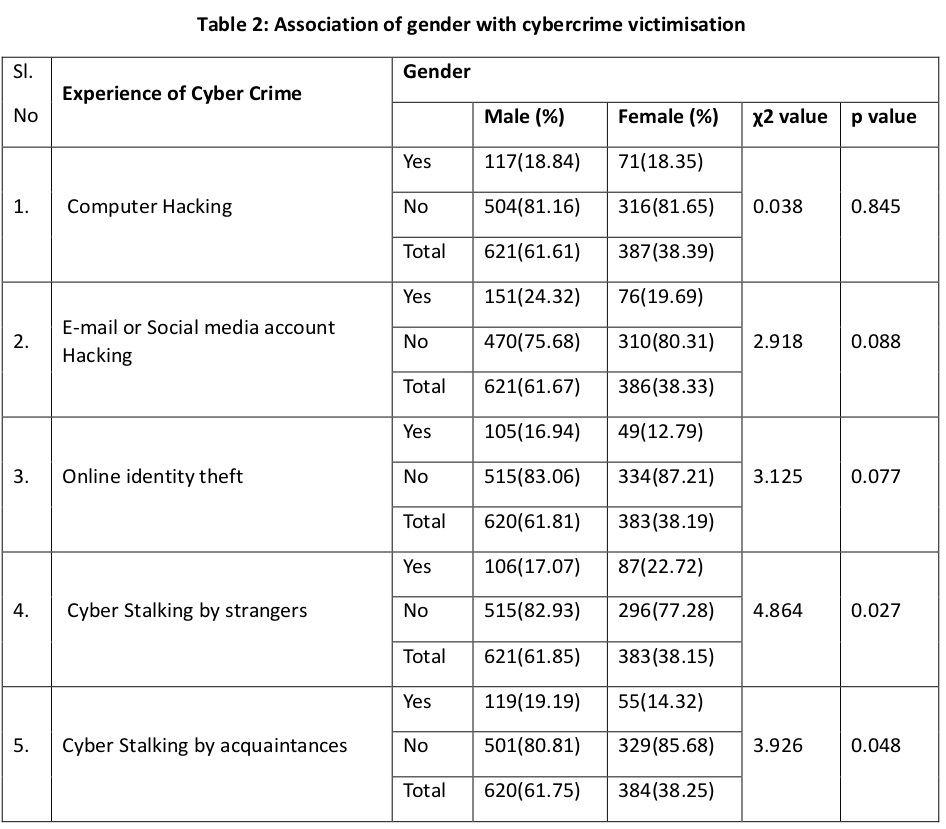
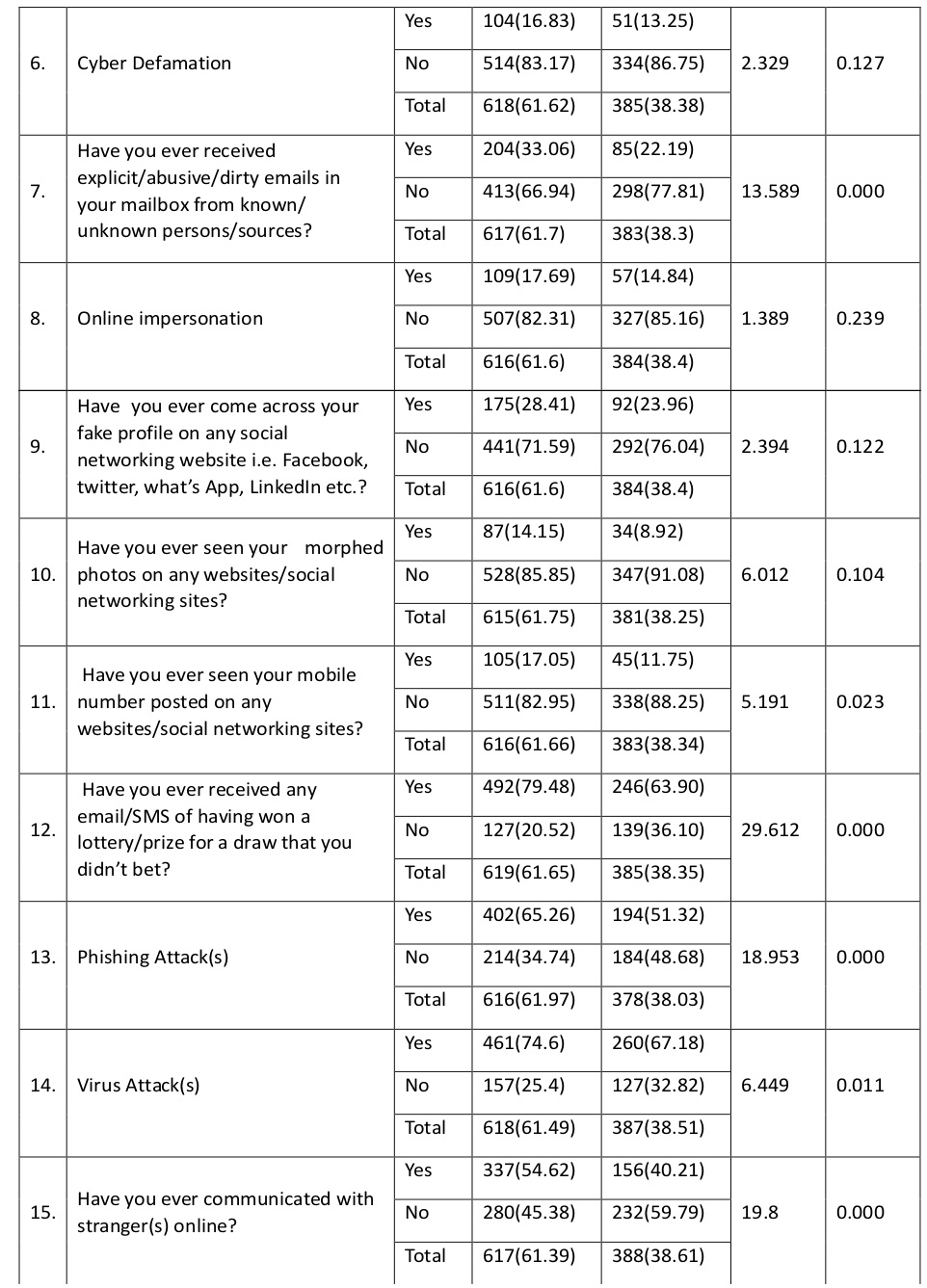
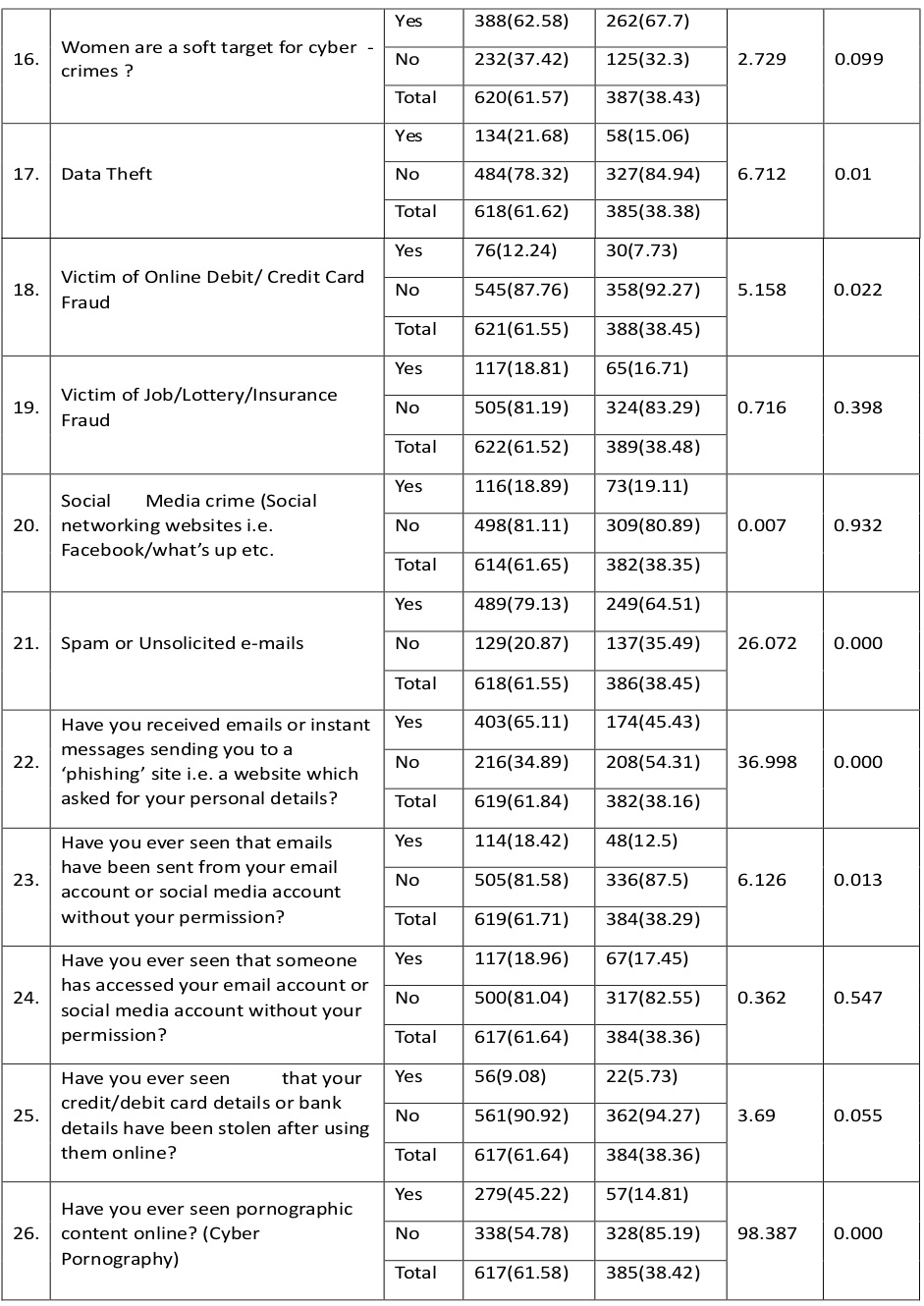
Table 3 presents the online presence of internet users per day. It shows that there is significant relationship between gender and online internet presence per day. Only 12 (1.94%) male and 35 (9.02%) female reported that they did not use internet. 319 (51.54%) male and 197 (50.77%) female reported their online internet presence per day as 4 hours or less. 205 (33.12%) male and 124(31.96%) female reported their online internet presence per day as 4 to 10 hours and 83 (13.41%) and 32 (8.25%) female reported online internet presence as more than 10 hours.
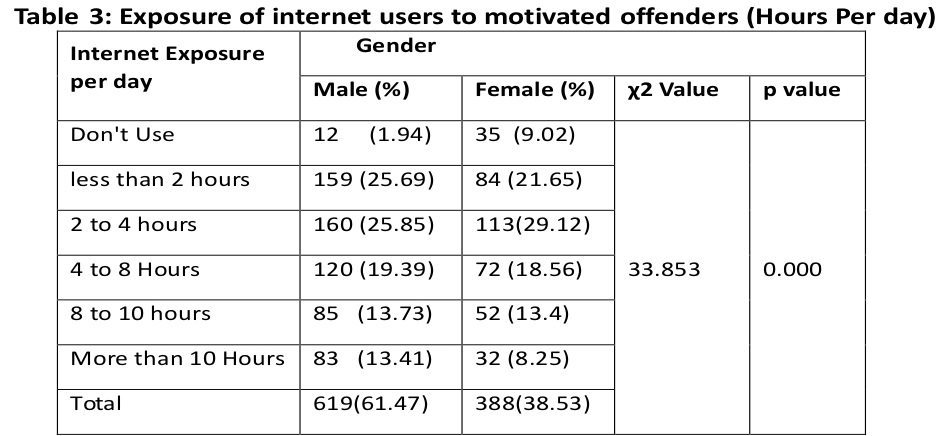
Table 4 presents the relationship of online security measure awareness with gender. It shows that 7(1.13%) male and 17(4.4%) female reported that they were not aware of anti-virus software and 102(16.5%) male and 74(19.17%) female reported that though they were aware about the anti-virus software but they did not use them. Therefore, it shows that 109(17.63%) male and 91(23.57%) female do not use anti-virus software. The table 4 also shows that there is significant relationship between online security measures awareness with gender(χ2 =12.647, p =0.002 for anti-virus software, χ2 =58.386, p =0.000 for firewall, χ2 =17.517, p =0.000 for Email Filters, χ2 =8.037, p =0.018 for wi-fi protection, χ2 =20.564, p = 0.000 for Ad blocking Software, χ2 =33.865, p = 0.000 for anti-spyware). The study reveals that 184(29.82%) male and 190(48.97%) female do not use firewall, 207(33.44%) male and 164(42.48%) female do not use email filters, 117(18.96%) male and 101 (26.23%) female do not use wi-fi protection and 314(50.73%) male and 259(67.28%) female do not use anti-spyware. Overall, it can be ascertained that female are less aware about inline security measures in comparison to males.
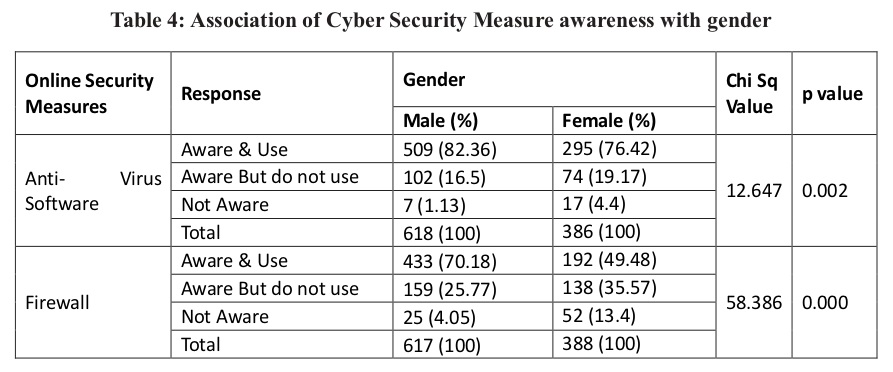
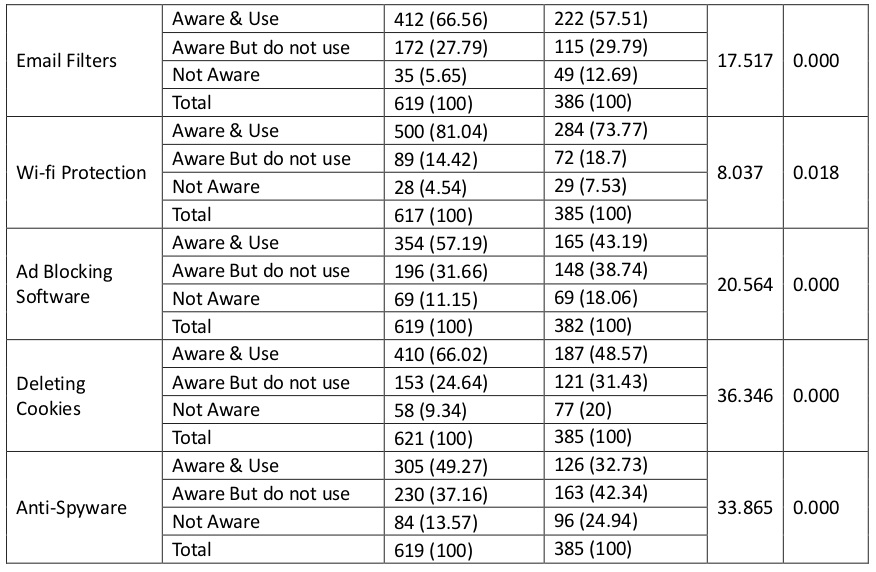
Table 5 presents the relationship of popularity of social networking sites with gender. The study revealsthat there is significant relationship between popularity of social media site and gender ( χ2 =29.819, p =0.000 for Facebook, χ2 =29.908, p = 0.000 for what’s app, χ2 =49.908, p = 0.0000for twitter, χ2 =12.443, p =0.010 for Instagram, χ2 =45.455, p = 0.000 for LinkedIn and χ2 =23.776, p = 0.000 for You tube). The study shows that What’s App is the most popular social media platform with 604(97.58%) male and 363 (93.56%) female users followed by Youtube with 599(96.77%) male and 358(92.01%) female users. Facebook got third place with 557(89.84%) male and 310 (80.10%) female users followed by Instagram with 402(65.37% male and 217(61.44%) female users .
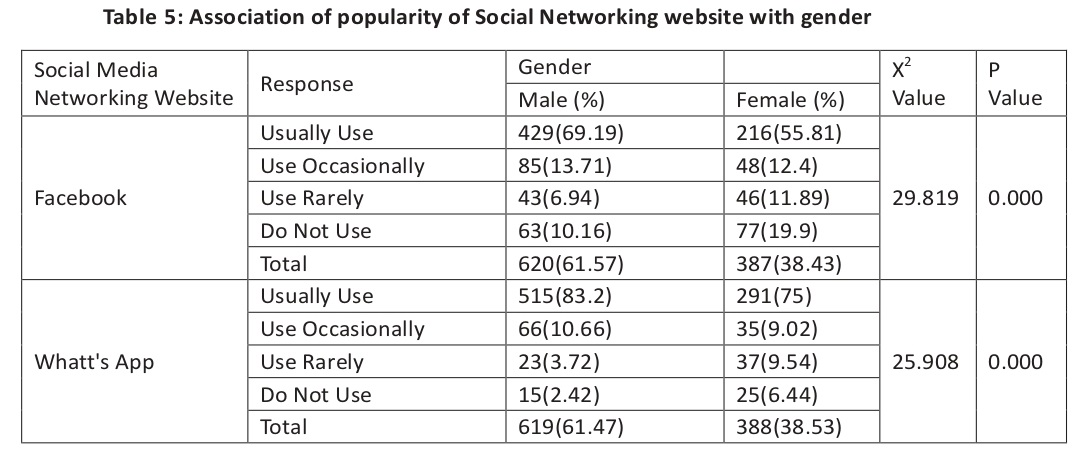
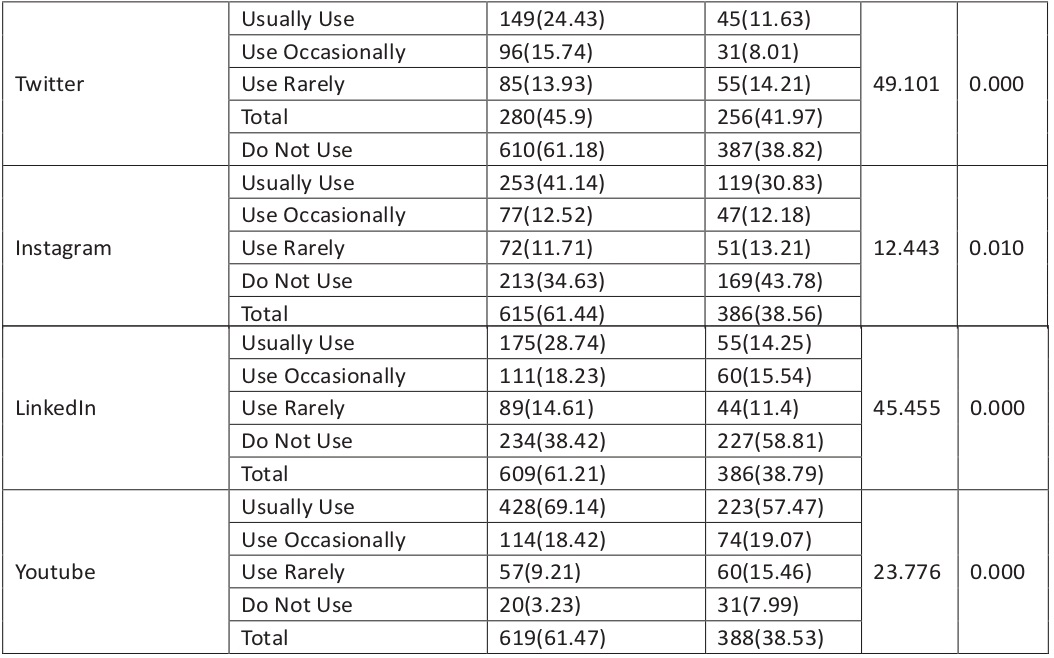
Table 6 represents relationship between sources of online information and gender. The study reveals that most commonly used online information source is Youtube with 605(97.42%) male users and 375 (96.90%) female users followed by wikipedia592 (95.79%) male users and 350 (89.97%) female users, followed by Search Engine 581 (94.17%) maleusers and 327 (84.72%) female users
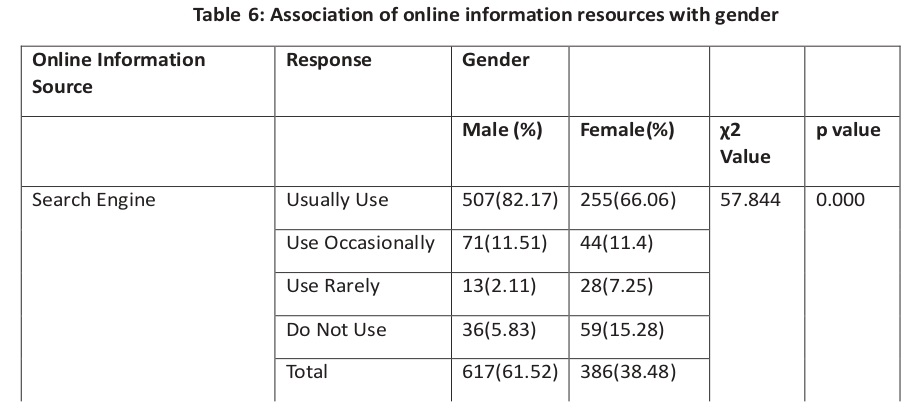
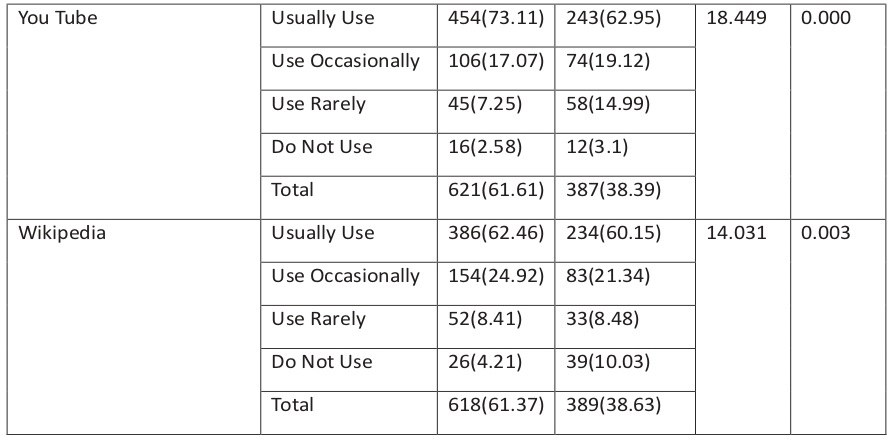
The study examined the role of gender on internet habits and cyber awareness of residents of district Gautam Budh Nagar, Uttar Pradesh, India. Cyber awareness, cybercrime victimization, exposer to motivated offenders (internet hours per day), online security measure awareness, popularity of social media platforms, sources of online information and online habits of the internet users were examined for ascertaining the presence of gendered differences (if any). Cyber awareness in females was found to be significantly more than the males in seven items out of the twelve items of the cyber awareness construct. Majority of the population felt that women were soft target of cybercrimes. Males outnumbered the females significantly in watching pornographic content online. It was found that cyber stalking, phishing attacks, virus attacks, data theft, online debit card/credit card frauds, unsolicited emails have significant association with gender, while hacking, online theft, cyber defamation and online impersonation had no significant association with gender. Further, it was found that there was significant gendered difference in the online internet presence per day of the users. Males were found to be significantly exposed more than the females. Gendered differences in online security measures awareness were found. Females were found to be significantly less aware than males as far as online security measures were concerned. WhatsApp was found to be most popular social media site followed by You tube and Facebook. It was revealed that males were using the social media sites significantly more than the females. Youtube followed by Wikipedia and search engines were found to be the popular sources on online information. The present research paper tries to make contribution to the literature by providing useful insight into the internet habits and cyber awareness. The study is able to examine and suggest that internet habits and cyber awareness play a very important role in the online communication and gendered differences exist in many constructs of internet habits and cyber awareness. This study will provide a fundamental authorization to have the understanding of differences between genders when any further study is done to seek linkage between gender and; internet habits and cyber awareness. The results are suggestive of gender specific interventions while dealing with the constructs of internet habits and cyber awareness. Most of the work in this regard is done in western context, this research gains importance in giving useful insights in Indian context. Though, these results are very encouraging, some of the limitations of the study may be noted. Firstly, this study was a cross-sectional study where data was collected at single point of time, therefore, causal interpretations over long term cannot be made which could have been possible with longitudinal or experimental design. One more limitation of this study was that it was limited to its surveyed respondents only, i.e. the residents of district Gautam Budh Nagar of Uttar Pradesh state in India. Therefore, the conclusions drawn from this study may not be generalized to the rural background and other smaller towns of the country. Future researches may seek to see if the results holds also good in other geographical areas of India and other countries. It can be safely summarized that these limitations provide further opportunity for probable research that may improve or extend this study. In spite of the abovementioned limitations, the results deliver deeper understandings that gender has impact on many aspects of the constructs internet habits and cyber awareness. Therefore, only looking at internet habits and cyber awareness without considering gender may provide flawed picture of the current scenario of usage pattern of cyber world.
Ang, C.-S. (2017). har. Computers in Human Behavior, 66, 1–6. https://doi.org/10.1016/j.chb.2016.09.028
India: digital population 2018 | Statistic. (2018). Retrieved December 26, 2018, from https://www.statista.com/statistics/309866/india-digital-population/
India: number of Facebook users 2022 | Statistic. (n.d.). Retrieved December 26, 2018, from https://www.statista.com/statistics/304827/number-of-facebook-users-in-india/
Internet usage in India - Statistics & Facts | Statista. (n.d.). Retrieved December 24, 2018, from https://www.statista.com/topics/2157/internet-usage-in-india/
Leung, L. (2009). Effects of motives for internet use, aloneness, and age identity gratifications on online social behaviors and social support among adolescents. Adolescent Online Social Communication and Behavior: Relationship Formation on the Internet. https://doi.org/10.4018/978-1-60566-926-7.ch008
Miller, J. M., Higgins, G. E., & Lopez, K. M. (2010). Considering the role of e-government in cybercrime awareness and prevention: Toward a theoretical research program for the 21st century. Citizens and E-Government: Evaluating Policy and Management. https://doi.org/10.4018/978-1-61520-931-6.ch012
Parihar, S., & Raheja, H. (2018). Youth Perception towards Internet Censorship in India. Pacific Business Review International, 11(3), 137–142. Retrieved from http://www.pbr.co.in/2018/2018_month/sep/16.pdf
Statistics Portal. (2017). Number of internet users in selected countries 2017 Statistic. Retrieved December 26, 2018, from https://www.statista.com/statistics/262966/number-of-internet-users-in-selected-countries/
Tokunaga, R. S. (2017). A meta-analysis of the relationships between psychosocial problems and internet habits: Synthesizing internet addiction, problematic internet use, and deficient self-regulation research. Communication Monographs, 84(4), 423–446. https://doi.org/10.1080/03637751.2017.1332419
Tsimtsiou, Z., Dantsi, F., Sekeri, Z., Trikoilis, N., & Nanos, P. (2017). Internet usage in primary and secondary school children: A multi-center, school-based, cross-sectional study in Greece. International Journal of High Risk Behaviors and Addiction, 6(2). https://doi.org/10.5812/ijhrba.33407
Wang, L., Luo, J., Gao, W., & Kong, J. (2012). The effect of Internet use on adolescents’ lifestyles: A national survey. Computers in Human Behavior, 28(6), 2007–2013. https://doi.org/10.1016/j.chb.2012.04.007
Research Scholar, Amity International Business School, Amity University Uttar Pradesh, Noida, India
Group Vice Chancellor, Amity Universities, India, Director General, Amity International Business School, Amity University Uttar Pradesh, Noida, India
Professor and Dean School of Business, Public Policy & Social Entrepreneurship (SBPPSE), Ambedkar University Delhi (AUD), Delhi, India
Professor - Decision Sciences, Amity Business School, Dy. Director - Research, Planning & Statistical Services
Amity University Uttar Pradesh, Noida, India